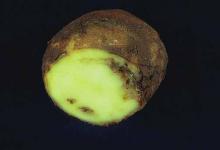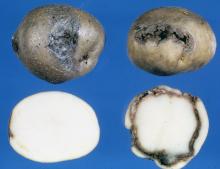By P. B. Hamm and C. M. Ocamb
Cause A bacterium, Clavibacter michiganensis subsp. sepedonicus (formerly Corynebacterium sepedonicum), which overwinters in infected tubers or as a dried slime on machinery and sacks, in storage houses, etc. It does not overwinter in soil except in infected volunteer plants. Knives used during seed-cutting operations can easily spread ring rot bacteria from infected tubers to healthy tubers.
Symptoms Symptom expression varies by variety. Foliage generally does not show symptoms until mid to late in the growing season. The first symptom is a shortened internode length in the terminals. These bunchy or rosetted terminals are a darker green than the rest of the plant. A pronounced yellowing occurs between leaflet veins, and the leaflet margin rolls up and becomes necrotic.
A "green wilt" also may occur with or without the above symptoms. One or more stems in a hill may show symptoms while the rest appear normal. When affected stems are cut at the ground line and squeezed, a creamy white mass of bacteria may ooze from the water-conducting tissue.
Ring rot in tubers may not develop until they have been in storage several months, or it may be present at digging or before. When infected tubers are cut near the stem end, ring rot symptoms may appear as yellow or light brown rings of cheesy consistency in the tuber's vascular ring. In advanced tuber rot, dry gray pockets of decayed tissue surround the vascular ring. Secondary rots may completely destroy the tuber, either in the soil or in storage.
Note: Plants and tubers, especially of 'Shepody', may be infected with ring rot bacteria without showing symptoms.
Cultural control
- Use only certified seed potatoes.
- Plant whole, single-drop seed. Avoid using picker planters because the pick spreads disease.
- Disinfect cutting knives at least three (3) times a day when cutting a single lot of potato seed. Always disinfect before cutting a new seed lot.
- Disinfect storage bins, tools, trucks, and other equipment frequently during cutting and planting operations. Always clean extensively before beginning seed handling operations at the start of the season.
Chemical control Disinfectants or fumigants with the following active ingredients are effective against bacterial ring rot. Check with your state Department of Agriculture to determine which formulations are acceptable for the area being cleaned. In general, disinfect by wetting the surface with the product for at least 10 min. Formaldehyde-based products are ineffective.
- Copper 8-Quinolinolate (PQ 80). Use a 10 % solution in a 1:200 dilution.
- Quaternary ammonium compounds at 5 oz of a 10% solution/10 gal water.
- Sodium hypochlorite in a 1,000 to 2,000 ppm chlorine solution. Ultra Clorox bleach can be used on seed potatoes and storages in Oregon, can only be used on seed potatoes as they are going through the cutting process in Washington. Check with your state Department of Agriculture to determine which formulations are acceptable for the item being cleaned.



